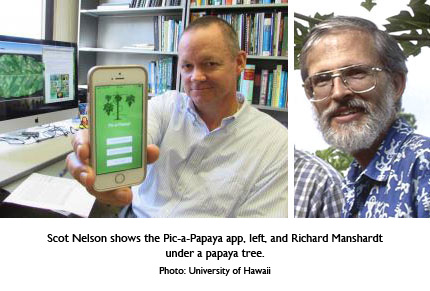Scot Nelson and Richard Manshardt, scientists with the University of Hawaiʻi at Mānoa’s College of Tropical Agriculture and Human Resources(CTAHR), have created a new citizen science app for iOS and Android users that tracks what they believe to be the declining incidence of papaya ringspot virus (PRSV) in the Honolulu area, as well as a possible increase in the incidence of PRSV-resistant genetically engineered papayas.
 As the scientists point out, the disease used to be common, from its appearance in the 1940s through the early 2000s. Its rapid spread devastated the papaya industry on Oʻahu in the 1960s and struck Big Island growers with 50 percent losses in the 1990s. Now, however, PRSV appears to be relatively rare. This may be due to the fact that the Rainbow papaya, genetically engineered by CTAHR, Cornell andUSDA researchers to be resistant to the virus, was introduced in 1998 after extensive testing and has been grown commercially for 15 years. By 2002, approximately half of the commercial papaya crop in Hawaiʻi was Rainbow, a development that has been credited with saving the papaya industry in the Islands. In 2009, about 77 percent consisted of Rainbow or the related genetically engineered SunUp, also released by CTAHR.
As the scientists point out, the disease used to be common, from its appearance in the 1940s through the early 2000s. Its rapid spread devastated the papaya industry on Oʻahu in the 1960s and struck Big Island growers with 50 percent losses in the 1990s. Now, however, PRSV appears to be relatively rare. This may be due to the fact that the Rainbow papaya, genetically engineered by CTAHR, Cornell andUSDA researchers to be resistant to the virus, was introduced in 1998 after extensive testing and has been grown commercially for 15 years. By 2002, approximately half of the commercial papaya crop in Hawaiʻi was Rainbow, a development that has been credited with saving the papaya industry in the Islands. In 2009, about 77 percent consisted of Rainbow or the related genetically engineered SunUp, also released by CTAHR.
But Nelson, a specialist in the Department of Plant and Environmental Protection Sciences, and Manshardt, a horticulturalist in the Department of Tropical Plant and Soil Sciences, are interested to learn how many papaya plants growing in home gardens or public areas are genetically engineered and of those that are not, how many are still harboring the virus. They hope their new Pic-a-Papaya project will help them gather this information.
Users can go to the Pic-a-Papaya website and download the free app, which will allow them to take pictures of papaya plants in the Honolulu metropolitan area—Hawaiʻi Kai to Kapolei—and send them to Nelson and Manshardt for diagnosis of PRSV. Each plant will be assessed a value of “healthy” or “diseased” and its GPS coordinates mapped. Users of the app can then view the map to see the distribution of infected plants.
Download the Pic-a-Papaya app
People who want to know whether their papaya plant is a genetically engineered variety can also find out for free by taking a sample of a leaf from the plant and mailing it to the scientists for testing. Further instructions for mailing the sample can be found at the project website.
Perhaps the most appealing aspect of the project is that it offers free papaya seeds to users who wish to replace papaya plants that have been diagnosed with PRSV or have been determined to be genetically engineered strains. A choice of either non-genetically engineered seed with partial virus tolerance or virus-resistant Rainbow or SunUp genetically engineered seeds is available.
Source: University of Hawaii
